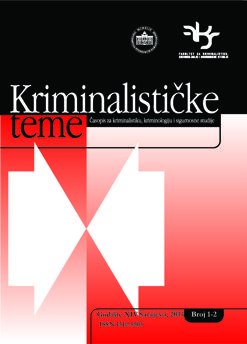KRIMINALISTIČKO-FORENZIČKI ZNAČAJ STALNIH OČNJAKA U IDENTIFIKACIJI I ODREĐIVANJU SPOLA
CRIMINALISTICS AND FORENSIC SIGNIFICANCE OF PERMANENT CANINES IN IDENTIFICATION AND SEX DETERMINATION
Author(s): Belma Muhamedagić, Nermin Sarajlić, Eldan Mujanović, Lejla MuhamedagićSubject(s): Gender Studies, Criminology, Health and medicine and law, Demography and human biology
Published by: Fakultet za kriminalistiku, kriminologiju i sigurnosne studije Univerziteta u Sarajevu
Keywords: identification; sex determination; canines; Maxillary Canine Index; Mandibular Canine Index;
Summary/Abstract: Sex determination is one of first and most important steps in process of identifying. It is quite often the case that during the exhumation of bodies from the mass graves and archaeological excavations, not all bones of one person are found, therefore, teeth and the scull are the only true identification material. Teeth are an excellent material for crimalistics and forensic investigation, and they have a great role in crime and forensic practice. Canines are teeth most appropriate for sex determination. The aim of this paper is to describe fundamental procedures of sex determination in case of examined population on grounds of odontometric characteristics of permanent canines, using the method according to Rao et al and explain this methodological procedure of ontological identification in terms of criminalistics research, that is, criminal procedure in broad terms. Patients and methods. The research sample included 180 patients of the Dental Office, of both sexes. In the research were included all patients with permanent lower right and left canines. Measurement was done directly in the patients’ mouth using a digital sliding calliperand values were expressed up to the hundredth part of millimetre. Result. Examination of Maxillary and Mandibular Canine Index (index of uper and lower canines/MaxCI, ManCI) indicates that its values were greater with male in relation to female (p<0.01). Precision of appraising the sex identity of the Bosnian-Herzegovinian population based on Maxillary Canine Index on the right amounts 63.33% and 66.67% on the left, and based on Mandibular Canine Index amounts 68.89%on the right and 68.54% on the left. Conclusions. The study showed that right canines are significantly broader than the left ones and they are broader in case of males. Mandibular Canine Index indicates greater accuracy in sex determination in relation to Maxillary Canine Index. The accuracy in sex determination for all variables is higher for the female.
Journal: Kriminalističke teme – Časopis za kriminalistiku, kriminologiju i sigurnosne studije
- Issue Year: XIV/2014
- Issue No: 1-2
- Page Range: 1-11
- Page Count: 11
- Language: Bosnian, Croatian, Serbian

